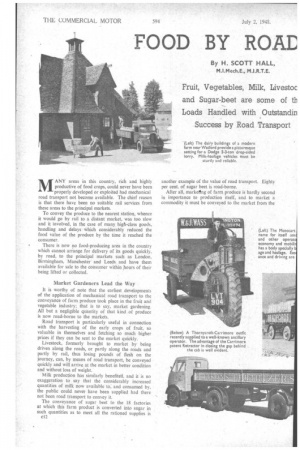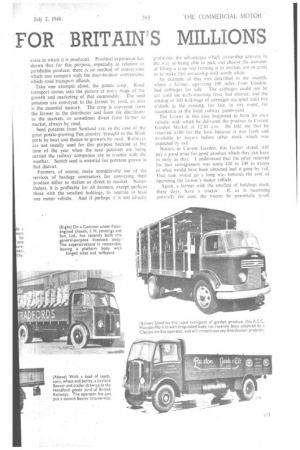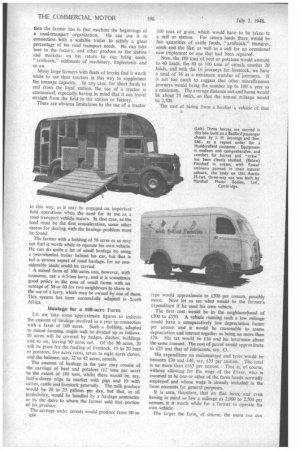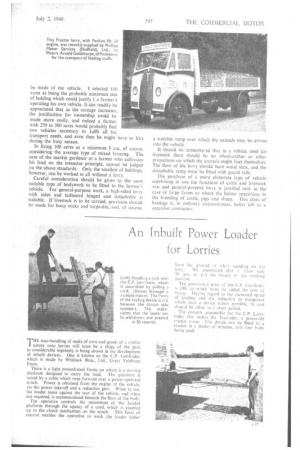FOOD BY ROAD FOR BRITAIN S MILLIONS
Page 54

Page 55

Page 56

Page 59

If you've noticed an error in this article please click here to report it so we can fix it.
By H. SCOTT HALL, M.I.Mech.E„ M.I.R.T.E.
Fruit, Vegetables, Milk, Livestoc and Sugar-beet are some of tli Loads Handled with Outstandin Success by Road Transport MANY areas in this country, rich and highly productive of food crops, could never have been properly developed or exploited had mechanical road transport not become available. The chief reason is that there have been no suitable rail services from these areas to the principal markets.
To convey the produce to the nearest station, whence it would go by rail to a distant market, was too slow and it involved, in the case of many high-class goods, handling and delays which considerably reduced the food value of the produce by the time it reached the consumer.
There is now no food-producing area in the country which cannot arrange for delivery of its goods quickly, by road, to the principal markets such as London, Birmingham, Manchester and Leeds and have them available for sale to the consumer within hours of their being lifted or collected.
Market Gardeners Lead the Way It is worthy of note that the earliest developments of the application of mechanical road transport to the conveyance of farm produce took place in the fruit and vegetable industry; that is to say, market gardening. All but a negligible quantity of that kind of produce is now road-borne to the markets.
Road transport is particularly useful in connection with the harvesting of the early crops of fruit, sä valuable in themselves and fetching so much higher prices if they can he sent to the market quickly.
Livestock, formerly brought to market by being driven along the roads, or partly along the roads and partly by rail, thus losing pounds of flesh on the journey, can, by means of road transport, be conveyed quickly and will arrive at the market in better condition and without loss of weight.
Milk production has similarly benefited, and it is no exaggeration to say that the considerably increased quantities of milk now available to, and consumed by, the public could never have been supplied had there not been road transport to convey it.
The conveyance of sugar beet to the 18 factories at which this farm product is converted into sugar in such quantities as to meet all the rationed supplies is c12 another example of the value of road transport. Eighty per cent, of sugar beet is road-borne.
After all, marketing of farm produce is hardly second in importance to production itself, and to market a commodity it must be conveyed to the market from the areas in which it is produced. Practical experience has shown that for this purpose, especially in relation to perishable produce,' there is no method of conveyance which can compare with the door-to-door convenience which road transport affords.
Take one example alone, the potato crop. Road transport comes into the picture at every stage of the growth and marketing of that commodity. The seed potatoes are conveyed to the farmer by road, as also is the essential manure. The crop is conveyed from the farmer to the distributor and from the distributor to the. markets, or sometimes direct from farmer to market, always by road.
. Seed potatoes from Scotland are, in the case of the great potato-growing Fen country, brought to the Wash ports by boat and thence to growers by road. Railways are not usually used for this purpose because at the time of the year when the seed potatoes are being carried the railway companies are in trouble with the weather. Scotch seed is essential for potatoes grown in that district.
Farmers, of course, make considerable use of the services of haulage contractors for conveying their produce either to station or direct to market.Nevertheless, it is profitable for all farmers, except perhaps those with the smallest holdings, to operate at least one motor vehicle. And if perhaps it is not directly
profitable. the advantages which ownership conveys in the way of being able to pick and choose the moment of lifting a crop and running it to market, are so great as to make that ownership well worth while.
An example of this was described to me recently where a farmer, operating 100 miles from London. had cabbages for sale. The cabbages could not be Cut until the early-morning frost had cleared, and the cutting of 300 half-bags of cabbages occupied until live o'clock in the evening, too late, in any event, for acceptance at the local railway goods-yard.
The farmer in this case happened to have his own vehicle, with which he delivered the produce to Covent Garden Market at 12.30 a.m. He told me that he received £180 for the load because it was fresh and available to buyers before other stock which was expected by rail.
Buyers in Covent Garden. this farmer stated, will pay a good price for good produce which they can have as early as that. I understand that the price received for that consignment was some £30 to £40 in excess of what would have been obtained had it gone by rail. That sum would go a long way towards the cost of operating the farmer's motor vehicle.
Again, a farmer with the smallest of holdings must. these days. have a tractor. If. as is becoming generally the case, the tractor be pneumatic tyred.
then the farmer has in that machine the beginnings of a road-transport organization. He can use it in connection with a suitable trailer to satisfy a great percentage of his road transport needs. He can takebeet to the factory, and other produce to the station and markets; on his return he can bring seeds.
• " artificials," oddments of machinery, implements and so on.
Many large farmers with fleets of lorries find it worth while to use their tractors in this way to supplement the.tonnage capacity. In any case, for short hauls to and from the local station, the use of a tractor is. economical, especially having in mind that it can travel straight from the field to the station or "factory.
There are obvious limitations to the use of a tractor in this way, as it may be engaged on important field operations when. the need for its use as a road transport vehicle occurs. En that case, as the land must be the first conaideration, some other means for dealing with the haulage problem must be found.
The farmer with a holding of 50. acres or so may not find it worth while to operate his own vehicle.. He can do quite a lot of serail haulage by using a two-wheeled trailerbehind his. car, but that isnot a serious aspect of road haulage. for no considerable loads could be carried.
A mixed farm of 100 acres can, however, with economy, use a 4-5-ton lorry, and it is sometimesgood policy in the case of small farms with an acreage of 50 or 60 for two neighbours to share in the use of a lorry, which may be owned by one of them. This. system has been successfully adopted in !outh Africa,
aataage for at 106-acre Farm Let me take some approximate figures to indicate the amount of haulage involved in a year in connection with a farm of 100 acres, Such a holding, adapted to mixed farming, might well be divided up as follows: 10 acres will be covered by hedges, ditches, buildings and so on, leaving 90 acres net. Of the 90 acres, 20 will be grass for the feeding of livestock, 15 to 20 beet or potatoes, five acres roots, seven to eight acres clover, and the balance, say, 32 to 42 acres, cereals.
The amount of haulage. in the year may consist of the carriage of beet and potatoes (12 tons per acre) to the extent of 180 tons, whilst there would be. say, half-a-dozen trips to market with pigs and 10 with calves, cattle and livestock generally. The milk produce would be 20 to. 25 gallons per day, but that, in. all probability, would be handled by a haulage contractor or by the dairy to whom the farmer sold that portion of his produce.
The acreage under cereals would produce from 80 to, et4
type would approximate to £200 per annum, possibly more. Now let us see what would be the farmer's expenditure if he used his own vehicle.
The first cost would be in the neighbourhood of £500 to £550. A vehicle running_ such a low mileage would have a comparatively low depreciation factor per annum and it would be reasonable to assess depreciation and interest together as being no more than £70. His tax would be £16 and his insurance about the same amount. The cost of petrol' would approximate to £25 and that of lubricants, say, £3.
His expenditure on maintenance and tyres would be between £30 and £40, say, £35 per annum. The total is no more than £165 per•annutri. That is, of course, without allowing for the wage of the driver, who is assumed to be one or other of the farm hands normally employed gad whose wage is already included _in the farm accounts for general purposes.
It is seen, therefore, that on that basis, and even, having in mind so low a mileage as 2,000 to 2,500 per annum, it is worth while for a farmer to operate his own vehicle.
The larger the farm, of course, the more use can be made of the vehicle. I selected 100 acres as being the probable minimum size of holding which could justify fle farmer's operating his own vehicle. It can readily be appreciated that as the acreage increases, the justification for ownership could be made more easily, and indeed a farmer with 250 to 300 acres would probably find two vehicles necessary' to fulfil all his transport needs, and even then he might have to hire during the busy season.
In fixing 100 acres as a minimum I am, of course, considering the average type of mixed farming. The case of the market gardener or a farmer who cultivates his land on the intensive principle, cannot be judged on the above standards. Only the smallest of holdings, however, can be worked at all without a lorry.
Careful consideration should be given to the most suitable type of bodywork to be fitted to the farmer's vehicle. For general-purpose work, a high-sided lorry with sides and tailboard hinged and detachable is suitable. If livestock is to be carried, provision should be made for hoop sticks and tarpaulin, and, of course, a suitable ramp over which the animals may be driven into the vehicle.
It should be remembered that in a vehicle used for livestock there should be no wheel-arches or other projections on which the animals might hurt themselves. The floor of the lorry should have wood slats, and the detachable ramp must be fitted with guard rails.
The purchase of a more elaborate type of vehicle combining in one the functions of cattle and livestock van and general-purpose lorry is justified only in the case of large farms or where the holder specializes in the breeding of cattle, pigs and sheep. This class of haulage is in ordinary circumstances, better left to a specialist contractor,












































































































